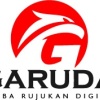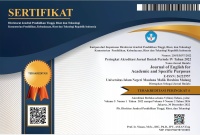ENGLISH FOR MEDIA LITERACY FOR EDUCATORS (EML-E) (MATERIAL RESUME AND REVIEW OF THE ONLINE PROFESSIONAL ENGLISH NETWORK (OPEN) BY GEORGE MASON UNIVERSITY)
Abstract
People are often discussing the media these days. In personal, professional, and educational contexts, social media, mass media, and media bias are regularly debated. Media literacy can understand, critique, and create media messages, while media messages are communicated via traditional or digital media. English Media Literacy (EML) analyses, provides and embeds media literacy as English language teaching in class. Educators realized in the late 20th century that they need to help their students "read" or "understand" different types of texts to guide students with a good mindset and acquire media messages as a skill and knowledge to become successful citizens of the 21st century. The new technologies and media started happening in the early 2000s or the beginning of the 21st century. This article served as material resume and review for the English for Media Literacy for Educators (EML-E) course as one of The Online Professional English Network (OPEN) By George Mason University. It is sponsored by the U.S. Department of State with funding provided by the U.S. government and administered by FHI 360. As media literacy is essential, this material resume is served by the author to cascade her new knowledge about this topic to increase its benefit. This paper will discuss five elements, they are: 1) Introduction to English for Media Literacy for Educators; 2) Approaches and Strategies for Media Literacy Education; 3) Managing Student Media Consumption and Production; 4) Language for Teaching English for Media Literacy, and 5) English for Media Literacy Unit Planning..
Full Text:
PDFReferences
CC BY SA by FHI 360. (2021). Untitled Image. The U.S. Department and FHI 360.
George Mason University. (2021a). English for Media Literacy for Educators Module 2 Downloadable Packet for the Online Professional English Network (OPEN). In English for Media Literacy for Educators (EML-E). The U.S. Department of State and FHI 360.
George Mason University. (2021b). English for Media Literacy for Educators Module 3 Downloadable Packet for the Online Professional English Network (OPEN). In English for Media Literacy for Educators (EML-E). The U.S. Department of State and FHI 360.
George Mason University. (2021c). English for Media Literacy for Educators Module 4 Downloadable Packet for the Online Professional English Network (OPEN). In English for Media Literacy for Educators (EML-E). The U.S. Department and FHI 360.
George Mason University. (2021d). English for Media Literacy for Educators Module 5 Downloadable Packet for the Online Professional English Network (OPEN). In English for Media Literacy for Educators (EML-E). The U.S. Department and FHI 360.
George Mason University. (2021e). Module 1: Introduction to English for Media Literacy for Educators (EML-E). In English for Media Literacy for Educators (EML-E). the U.S. Department of State and FHI 360.
Kimmons, R., Graham, C. R., & West, R. E. (2020). The PICRAT model for technology integration in teacher preparation. Contemporary Issues in Technology and Teacher Education, 20(1). https://citejournal.org/volume-20/issue-1-20/general/the-picrat-model-for-technology-integra%0Ation-in-teacher-preparation
Rogow, F., & Scheibe, C. (2017). Key questions to ask when creating media messages. Adapted from NAMLE’s Core Principles for Media Literacy Education. https://namle.net/resources/key-questions-for-analyzing-media/
Shin, J. K. (2007). Developing dynamic units for EFL. English Teaching Forum, 45(2), 2–8.
Shin, Joan Kang. (2021). “Cyberbullying Word Web.” licensed under CC BY 4.0.
The U.S. Department of State and FHI 360. (2021). Media Log Assignment for the Online Professional English Network (OPEN). Creative Commons Attribution 4.0 License. https://creativecommons.org/licenses/by/4.0/
DOI: https://doi.org/10.18860/jeasp.v4i2.14432
Refbacks
- There are currently no refbacks.





Editorial Office:
Pusat Pengembangan Bahasa
Program Khusus Pengembangan Bahasa Inggris (PKPBI)
Universitas Islam Negeri Maulana Malik Ibrahim Malang
Gedung C lantai 1
Jl. Gajayana No 50 Kota Malang, Jawa Timur, Indonesia
Kode Pos 65144, Telp/Fax : (0341) 570872
Email: jeasp@uin-malang.ac.id







